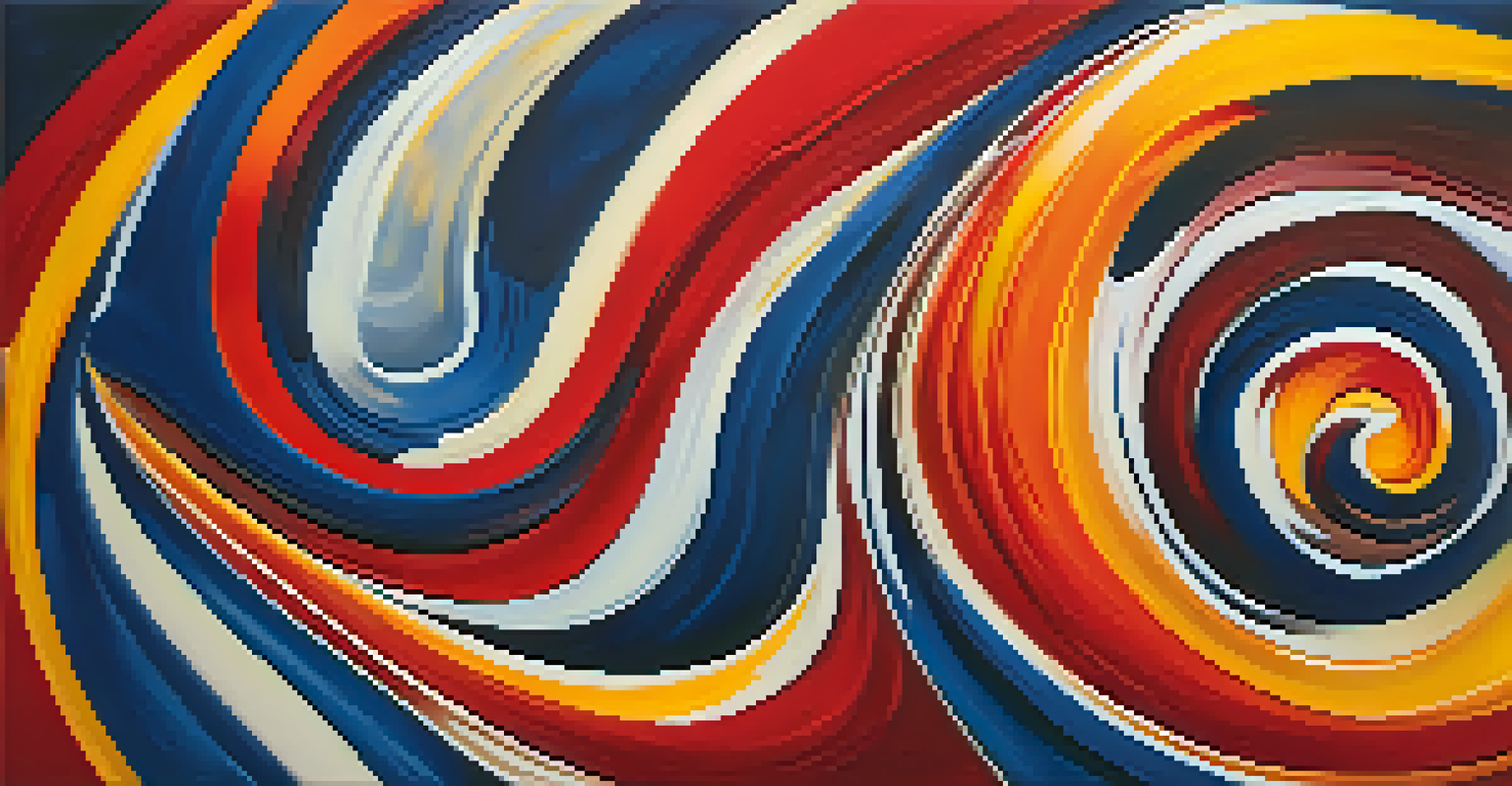Artistic Interpretation: The Viewer’s Subconscious Response

What is Artistic Interpretation in Art?
Artistic interpretation refers to the unique meaning that viewers derive from an artwork. It’s like looking at a painting and feeling a rush of emotions that resonate with your personal experiences. Each piece of art is a canvas for imagination, inviting observers to explore their own thoughts and feelings.
Art is the most beautiful of all lies.
The beauty of artistic interpretation lies in its subjectivity; what one person sees might differ vastly from another's perspective. For instance, a vibrant sunset painting may evoke joy in one viewer while sparking nostalgia in another. This variance showcases how art can transcend mere visuals and tap into the viewer's subconscious.
Ultimately, artistic interpretation helps bridge the gap between the artist's intentions and the audience's reception. It's this interplay that makes art a powerful medium for communication, as it encourages a dialogue that goes beyond words.
The Role of the Viewer’s Subconscious Mind
When we engage with art, our subconscious plays a crucial role in shaping our responses. It’s akin to how certain scents can trigger memories long forgotten, often evoking emotions that we didn’t realize were still present. Similarly, art can awaken feelings and insights that dwell beneath the surface of our conscious thoughts.

This subconscious reaction is influenced by various factors, including our background, experiences, and cultural context. For example, a piece depicting a rural landscape might remind someone of childhood summers spent in the countryside, while another viewer may simply appreciate the beauty of the scene. Both responses are valid, highlighting the power of personal memory in interpreting art.
Art Reflects Personal Experiences
Each viewer's unique memories and emotions shape their interpretation of art, making it a deeply individual experience.
In this way, the viewer's subconscious acts as a lens, filtering and amplifying the emotions stirred by the artwork. It’s this interaction that makes art appreciation such a deeply personal and unique experience.
How Art Evokes Emotional Responses
Art has a remarkable ability to evoke emotions, often in ways that words cannot capture. Think of a haunting melody that stirs feelings of sadness or joy; similarly, an artwork can visually resonate with our emotions. Colors, shapes, and textures all contribute to this emotional landscape, creating a rich tapestry that invites reflection.
Every artist dips his brush in his own soul, and paints his own nature into his pictures.
For instance, the use of bold reds and oranges in a painting might ignite feelings of passion or anger, while soft blues and greens can evoke tranquility. Artists often employ these elements intentionally, guiding viewers toward a desired emotional response. However, the interpretation ultimately remains in the hands of the audience.
This emotional connection is what makes art so compelling. It invites us to pause, reflect, and engage with our feelings, often leading to deeper self-discovery.
Cultural Influences on Artistic Interpretation
Cultural backgrounds significantly shape how we interpret art. Different cultures bring distinct perspectives, traditions, and narratives that influence our understanding and appreciation of an artwork. For example, a piece rich in symbolism may be interpreted differently by someone familiar with that culture's history compared to someone who is not.
Consider how a flower in a painting might symbolize purity in one culture while representing death in another. Such contrasts highlight the complexity and richness of artistic interpretation, as each viewer's cultural lens colors their understanding. This diversity enriches art, allowing for a multitude of interpretations to coexist.
Cultural Context Shapes Interpretation
Different cultural backgrounds influence how we perceive and understand artwork, highlighting the richness of diverse interpretations.
Recognizing these cultural influences can deepen our appreciation for artworks. Engaging with art from various cultures encourages us to broaden our horizons and celebrate the richness of human expression.
The Impact of Personal Experiences on Interpretation
Our personal experiences profoundly influence how we interpret art. Each viewer brings a unique set of memories, thoughts, and emotions that shape their understanding of an artwork. For instance, a piece depicting a family gathering might evoke feelings of warmth and nostalgia for someone with fond memories of similar moments.
Conversely, the same artwork may resonate differently with someone who has experienced loss or estrangement from family. This illustrates how personal context can transform our emotional engagement with art, making it a deeply individual experience.
Art becomes a mirror reflecting our own life stories, allowing us to explore our emotions and experiences. By recognizing this connection, we can appreciate how art serves not just as a visual experience but also as a pathway to self-exploration.
The Role of Context in Artistic Interpretation
Context plays a pivotal role in shaping our interpretation of art. This includes the historical, social, and political backdrop against which an artwork is created. Understanding the context can provide deeper insight into the artist's intentions and the themes they wish to convey.
For example, a painting created during a time of war may express themes of struggle and resilience, reflecting the societal mood of that era. Without this context, a viewer might miss the deeper significance embedded within the artwork. Thus, context acts as a crucial key that unlocks richer layers of meaning.
Context Enhances Artistic Meaning
Understanding the historical and social context of an artwork unlocks deeper layers of meaning and enriches our engagement.
Being aware of the surrounding circumstances enhances our engagement with art. It invites us to consider not just what we see, but also the story behind the piece, fostering a more profound connection with the artwork.
The Journey of Artistic Interpretation
Artistic interpretation is not a one-time event; it’s a journey that evolves over time. As we grow and change, so do our perspectives on art. A piece that once held little meaning may resonate deeply years later, as our life experiences shape our interpretation.
This evolution is part of what makes art so powerful. It can accompany us through different stages of our lives, offering new insights and reflections as we face new challenges and triumphs. Each viewing can unveil fresh layers of meaning, keeping the conversation between the viewer and the artwork alive.

Embracing this journey encourages us to revisit artworks and allow our subconscious to guide our interpretation. Art becomes a living dialogue, evolving alongside us and enriching our understanding of ourselves and the world around us.